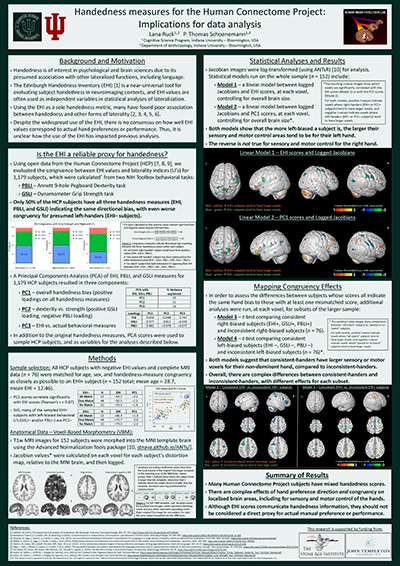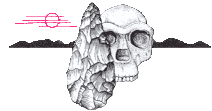Stone Age Institute Researchers Win
Best Poster Award
Graduate student Lana Ruck and S.A.I. researcher Dr. Tom Schoenemann won "Best Poster Award" at the 6th North Sea Laterality conference, which was held in Dundee, Scotland, in August of 2018. The poster, which was titled "Handedness Measures for the Human Connectome Project: Implications for Data Analysis" is about how different measures of handedness relate to each other, and about the potential mis-use of handedness surveys in scientific research. The team is primarily interested in how handedness evolved in our lineage, as well as how handedness relates to the organization and function of human brains. Unfortunately, many scientists in the brain-imaging community have recently argued that handedness does not relate to brain asymmetries (in structure or in function). If true, this makes evolutionary studies of handedness inconsequential for tracking cognitive evolution, an argument which many anthropologists have used for decades.
In the poster, Ruck and Schoenemann suggest that most of these researchers only use one measure of handedness: a 10 question survey. The team showed that handedness survey responses do not actually match hand skill for natural behaviors, meaning that the brain-imaging community may be relying on flawed methods to make their claims. Their hope is to convince others to use more realistic measures of handedness in their studies, so that we can truly answer questions about the relationship between handedness and brain organization (especially for functions like language, which are mostly localized to only one half of the brain). Once we know more about the relationship between handedness and brain organization in living humans, the hope is to extend our knowledge of handedness back in time using the archaeological record. Words, and the brains that made them, do not fossilize, but we might get a sense of when the uniquely-human system of asymmetry, or laterality, evolved using evidence related to handedness instead. Presenting these findings, and winning an award, at a specialized meeting for laterality researchers is a hopeful sign for productive change in future studies.
Lana Ruck is a Ph.D. candidate in Anthropology and Cognitive Science, working with Stone Age Institute staff on the evolution of laterality. Lana is also passionate about science communication, and manages Indiana University's very own science blog, ScIU; you can read more about her on the ScIU website. Tom Schoenemann is an Associate Professor in Anthropology and Cognitive Science who studies the evolution of brain and behavior, with a specific focus on language evolution; for more info, visit his lab website.


